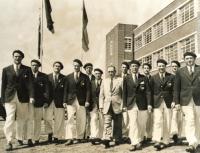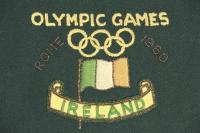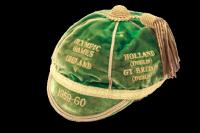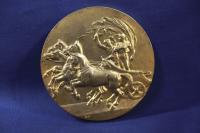Museum eye: ‘Patriot Games: Ireland and the Olympics’ Louth County Museum, Jocelyn Street, Dundalk
Published in 18th–19th - Century History, 20th-century / Contemporary History, Issue 4 (July/August 2012), Reviews, Volume 20
Members of the Irish team for the 1948 London Olympics—one of the many photos on display. (Maurice Coyle)
Located on the top floor, ‘Patriot Games’ looks at Irish involvement in the Olympics in the last 100 years—another ambitious project from Louth County Museum. It consists of a series of information panels, video screens and artefacts reflecting not just the development of the games themselves but also the evolution of athletics in Ireland and Irish society. The exhibition runs clockwise and through a series of alcoves guides the visitor from the 1912 Stockholm games to 2008 in Beijing. The panels give a history of the games in question and put the Irish involvement into context. One theme running through the early years was the Irish struggle for recognition as a separate nation, even after the establishment of the Irish Free State. Problems were not always caused by international bodies refusing to acknowledge Ireland but sometimes by rival sporting organisations, each claiming to be the national body. This was a particular problem in cycling, which persisted until the 1970s.Another is how many Irish-born athletes represented other nations at the Olympics: K.K. McArthur won a gold medal in the marathon for South Africa, while Peter McArdle ran in the marathon for the United States at the Tokyo games. Representation of women was a hot topic too. While women participated in various events from the beginning, many considered it unseemly for them to be athletes and in Ireland there was no great encouragement for women to become Olympians. Even as late as 1956, for example, runner Maeve Kyle received abuse for taking part in the 1956 Melbourne games, although she went on to take part in two more Olympics. Ironically, by the 1990s Ireland’s medal hopes rested on women such as Sonia O’Sullivan and Michelle Smith.Words do not dominate the panels, as there is good use of imagery too. There are photographs, posters, stamps and logos. We can see a steady progression from art inspired by classical Greek motifs to more modern concepts of a logo. The posters and logos also show changes in attitude, from a period when the dignity of the games and the importance of participation were emphasised to more recent times when they are promoted to a greater extent as entertainment, with each city stamping its own brand on the Olympics. One startling image comes from the 1936 games in a Berlin dominated by the Nazi swastika.

The Irish team logo for the 1960 Rome Olympics. (Louth County Museum)
In between each alcove is a panel concentrating on local heroes—Louth athletes who took part in the games. For a ‘wee county’ it can boast a broad range of participants and medal-winners. An early Louth Olympian was Beatrice Hill Lowe, who came third in the archery competition at the 1908 London games. As today, Ireland’s best chances for a medal were often in boxing, and Drogheda boxer Tony Byrne won a bronze medal in Melbourne. The celebrated runner Noel Carroll was born at Annagassan and represented Ireland at the Tokyo and Mexico Olympics. Perhaps the most unusual achievement was in the 1908 games, when Ireland won a gold medal by beating Germany in the cycle polo final. This sport was invented in County Wicklow in 1891 by retired cyclist Richard J. Mecredy.That medal is on display alongside other artefacts from Irish Olympic history. Each alcove has cabinets containing memorabilia and souvenirs of various Olympic games. There are medals, of course, but also the uniforms worn by the Irish team at the opening ceremony, shorts and singlets worn by athletes, a cap from the 1959–60 football qualifying tournament, programmes, documents, letters, trophies and souvenirs brought back by Olympians. Two items stand out for their size alone. One is the 4m kayak used by Éadáoin Ni Challaráin in the 2000 and 2004 Olympics, and the other is a bobsleigh used in training by the Irish Winter Olympics team. These are near the ‘wall of fame’ containing the photographs of over 700 of Ireland’s Olympians.

A football cap awarded for the qualifying campaign for the 1960 Rome Olympics. (Louth County Museum)
While going through the exhibition you will come across video screens running films of Olympic games, documentaries on different athletes and interviews with surviving Olympians such as Ronnie Delany. These interviews really make the whole thing come alive, as the athletes talk about their experiences, their reactions to success or failure, and what participating in the games meant to them. In their honesty they run from the upbeat to the painful but ultimately are uplifting testimonies to Ireland’s Olympic history. As you leave the exhibition you are confronted by James Hanley’s famous portrait of Ronnie Delany, probably Ireland’s most loved Olympic champion.This is an exhibition that leaves you thinking. Many of the images will stay in your head long afterwards, as will some of the quotations from the athletes themselves. It reminds us of how far Ireland as a nation has come in international sport and how, rather like Louth itself, its achievements have outweighed its population and resources. HI

A medal won by one of the Oswald brothers in 1908 for ‘bicycle polo’, a sport invented in County Wicklow in 1891 by retired cyclist Richard J. Mecredy. (Louth County Museum)
















